
Caracas, officially Santiago de León de Caracas (CCS), is the capital and largest city of Venezuela, and the center of the Metropolitan Region of Caracas. Caracas is located along the Guaire River in the northern part of the country, within the Caracas Valley of the Venezuelan coastal mountain range. The valley is close to the Caribbean Sea, separated from the coast by a steep 2,200-meter-high (7,200 ft) mountain range, Cerro El Ávila; to the south there are more hills and mountains. The Metropolitan Region of Caracas has an estimated population of almost 5 million inhabitants.

TransMilenio is a bus rapid transit (BRT) system that serves Bogotá, the capital of Colombia, and Soacha, a neighbouring city. The system opened to the public in December 2000. As of 2024, 12 lines totalling 114.4 km (71 mi) run throughout the city. It is part of the city's Integrated Public Transport System, along with the urban, complementary and special bus services operating on neighbourhood and main streets.

The Caracas Metro is a mass rapid transit system serving Caracas, Venezuela. It was constructed and is operated by Compañía Anónima Metro de Caracas, a government-owned company that was founded in 1977 by José González-Lander who headed the project for more than thirty years since the early planning stages in the 1960s. Its motto is "Somos parte de tu vida". In 1978 MTA – New York City Transit's R46 #816 was shipped from the Pullman Standard's plant as a sample of rolling stock to be used for the new metro system that was under construction at the time.

El Gran Silencio is a rock en español band from Monterrey, Mexico that blends a variety of rock, reggae, dancehall, and hip-hop influences with traditional Latin American musical forms such as cumbia, vallenato and Norteño. Their lyrics tend to be bohemian and often talk about life in the “barrio” or poor neighborhoods of Mexican cities, especially Monterrey. As of 2015, they have recorded seven albums, eleven singles, six soundtracks, five tributes and seventeen collaborations and have toured Mexico and the United States.

Carlos Raúl Villanueva Astoul was a Venezuelan modernist architect. Raised in Europe, Villanueva went for the first time to Venezuela when he was 28 years old. He was involved in the development and modernization of Caracas, Maracay and other cities across the country. Among his works are El Silencio Redevelopment which included 7797 apartments and 207 shop premises and the Ciudad Universitaria, the main campus of the Central University of Venezuela. The Campus was declared a World Heritage Site by UNESCO in the year 2000.

Radio Caracas Radio was a Venezuelan radio station. Founded in 1930, it was Venezuela's oldest radio station. It was last owned by Empresas 1BC, a Venezuelan private media corporation. The station was shut down in 2023 by the Nicolás Maduro administration.
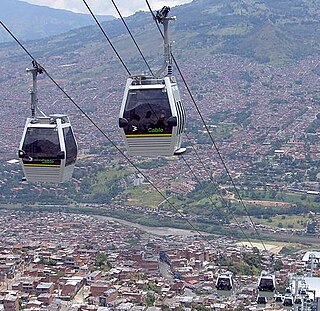
Metrocable is a gondola lift system implemented by the City Council of Medellín, Colombia, with the purpose of providing a transportation service that complements the Medellín Metro. It was designed to reach some of the city's informal settlements on the steep hills that mark its topography. It is largely considered to be the first urban cable propelled transit system in South America. The transportation infrastructure is already established and has been in service since 2004.

The Teleférico de Caracas is a gondola lift that ascends El Ávila Mountain within El Ávila National Park, in Caracas, Venezuela.
El Silencio may refer to:
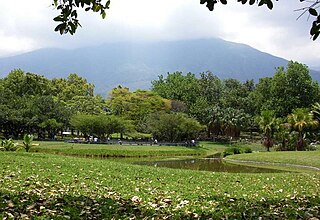
El Parque del Este, renamed as officially Generalissimo Francisco de Miranda Park by Chávez since, in honor of the Venezuelan national hero, is a public recreation park located in the Sucre Municipality of Metropolitan Caracas in Venezuela. Opened in 1961, it is one of the most important of the city, with an area of 82 hectares. The park was designed by Roberto Burle Marx and associates Fernando Tabora and John Stoddart.
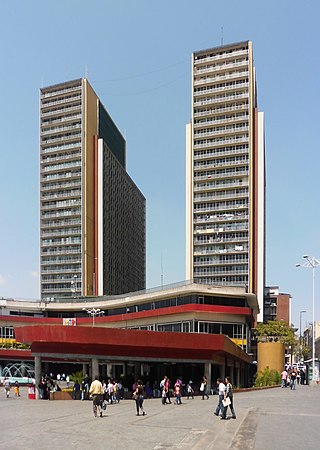
The Centro Simón Bolívar Towers TCSB also known as the Towers of Silence is a building with a pair of 32-story towers, each measuring 103 meters in height, in El Silencio district, Caracas, Venezuela. Built during the time of the presidency of Marcos Pérez Jiménez, the TCSB was opened to the public on December 6, 1954.

The Palacio de las Academias is a Neo-Gothic building on the Avenida Universidad in the centre of Caracas, Venezuela. It dates back to 1684 when a Franciscan convent was built on the site but in the 19th century it served as a barracks, a hospital and a college. In 1876, under President Antonio Guzmán Blanco, the Universidad de Caracas was moved to the building, whose former colonial façade was rebuilt in the Neo-Gothic style. After the university relocated to a new campus in 1952, the building became home to the National Academies. In 1965, it was listed as a national monument. The Palacio de las Academias now houses six National Academies, which are the National Academy of History, the Venezuelan Academy of Language, the Academy of Medicine, the Academy of Political and Social Sciences, the Academy of Jurisprudence, and the Academy of Physics, Mathematics and Nature.
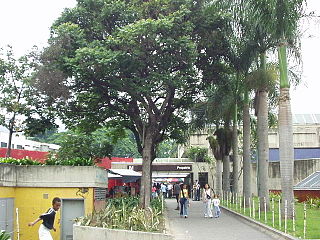
Propatria is a Caracas Metro station on Line 1. It was opened on 2 January 1983 as part of the inaugural section of Line 1 between Propatria and La Hoyada, and is located on Avenida 2 de Propatria. It serves as the western terminus of the line. The following station is Pérez Bonalde. Trains run from the station every three minutes.
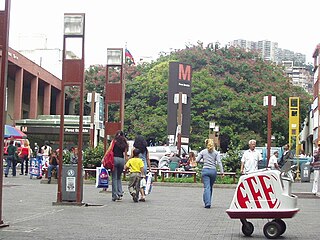
Pérez Bonalde is a Caracas Metro station on Line 1. It was opened on 2 January 1983 as part of the inaugural section of Line 1 between Propatria and La Hoyada, and is on Catia Boulevard. The station is between Propatria and Plaza Sucre.
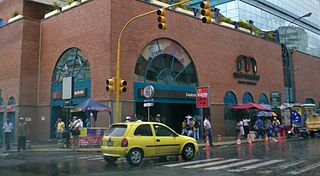
Capitolio is a Caracas Metro station on Line 1. It was opened on 2 January 1983 as part of the inaugural section of Line 1 between Propatria and La Hoyada. The station is between Caño Amarillo and La Hoyada. It is a transfer station, connected with Line 2 via El Silencio. The station is located at the corner of Avenida Universidad and Avenida Baralt.

El Silencio is a Caracas Metro station on Line 2. It was opened on 6 November 1988 as part of the extension of Line 2 from La Paz to El Silencio. The station serves as the northern terminus of the line and it is a transfer station, connected with Line 1 via Capitolio. The following station is Capuchinos.

La Paz is a Caracas Metro station on Line 2. It was opened on 4 October 1987 as part of the inaugural section of Line 2 from La Paz to Las Adjuntas and Zoológico. The station served as the northern terminus of Line 2 until 6 November 1988, when the line was extended to El Silencio. The station is between Artigas and La Yaguara.
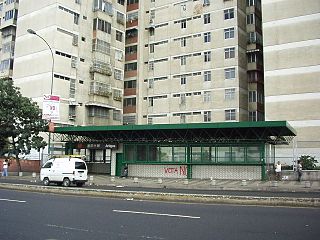
Artigas is a Caracas Metro station on Line 2. It was opened on 6 November 1988 as part of the extension of the line from La Paz to El Silencio. The station is between Maternidad and La Paz.

Maternidad is a Caracas Metro station on Line 2. It was opened on 6 November 1988 as part of the extension of the line from La Paz to El Silencio. The station is between Capuchinos and Artigas.

















